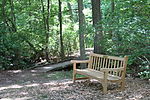Lighthouse Hill, Staten Island
Lighthouse Hill is the name of a hill, and the neighborhood situated thereon, in the New York City borough of Staten Island. Lighthouse Hill is situated to the north of Richmondtown, south of Todt Hill, and west of Grant City. Formerly known as Richmond Hill (and not to be confused with the neighborhood of the same name in the borough of Queens), Lighthouse Hill acquired its present name when the Staten Island Range Light, towering 141 feet (43 m) above the Lower New York Bay, was built there in 1912. Its original light could be seen as far as 21 miles (34 km) away. The former name of Richmond Hill survives in Richmond Hill Road, located at the southern edge of the hill. Lighthouse Hill is the southernmost of the chain of hills that radiate from the northeast corner of Staten Island and separate its East Shore from the region behind the hills, usually referred to as Mid-Island by island residents. Richmond Creek flows near the bottom of the hill's eastern ridge, and it is surrounded on all sides by parks belonging to the Staten Island Greenbelt, with the LaTourette Golf Course at the hill's southern margin.
Excerpt from the Wikipedia article Lighthouse Hill, Staten Island (License: CC BY-SA 3.0, Authors).Lighthouse Hill, Staten Island
Terrace Court, New York Staten Island
Geographical coordinates (GPS) Address Nearby Places Show on map
Geographical coordinates (GPS)
| Latitude | Longitude |
|---|---|
| N 40.578055555556 ° | E -74.135 ° |
Address
Terrace Court
Terrace Court
10306 New York, Staten Island
New York, United States
Open on Google Maps








